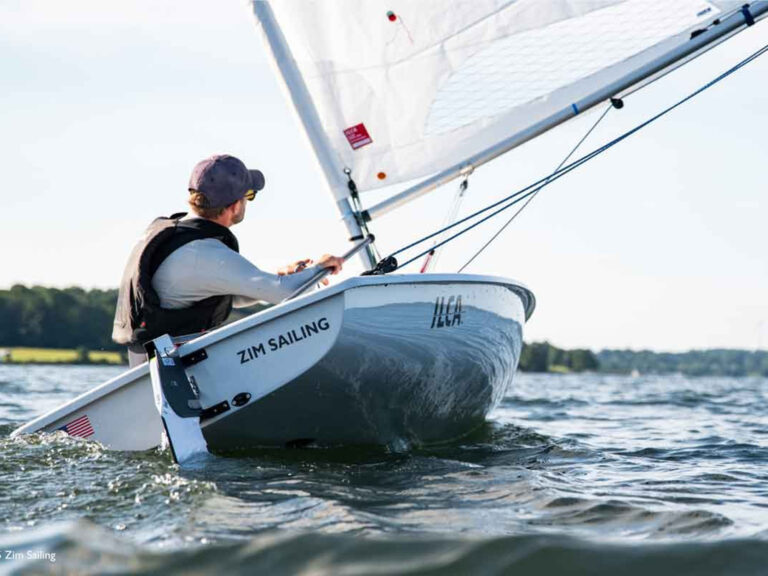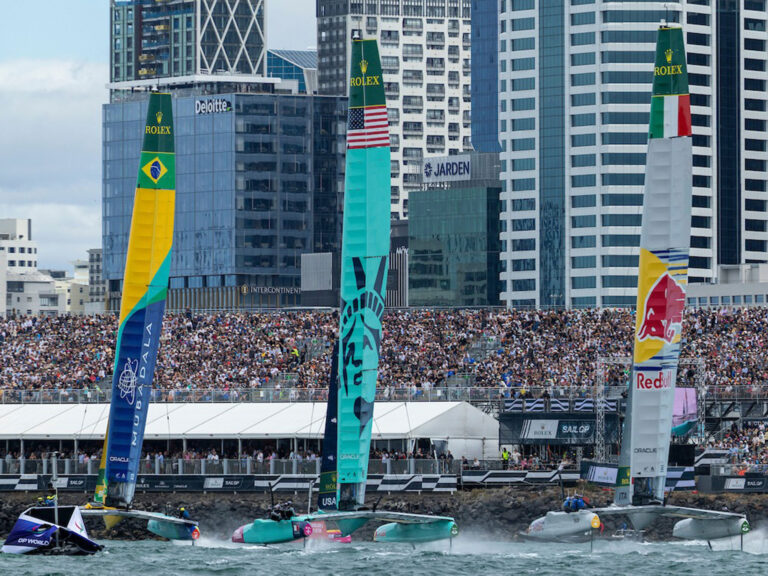Its no harder or easier to win races in mulithulls, its just a little different because in multihulls you gain or lose at a much faster rate than on a monohull. To win, however, requires an understanding of racecourse basics at starts, mark roundings, and finishes. Of those areas, the leeward mark rounding is the best place to pass boats. There are four leeward-mark must-dos: 1. Set up for the rounding 2. Remember the inside overlap 3. Avoid the pinwheel 4. Enter wide, exit close.
Set up for the rounding
As you approach the leeward mark, reverse any sail adjustment you made after you rounded the weather mark. Get the boat ready for the weather leg, and do it early. All you should be doing as you round is sheeting and steering–don’t even chew your gum. Both skipper and crew should be hooked to the trapeze wire as well. As soon as you clear the mark, you need to be out of the boat and trapping.
Remember the inside overlap
First, you must know when and if other boats have an overlap. Draw an imaginary line perpendicular to your stern, and if any part of any other boat intersects that line, theres an overlap. When you approach a leeward mark, if any of those boats are on your inside, they have an inside overlap, which means youll have to let them pass between you and the mark.
Overlaps can be hard to determine for multihull sailors because the boats are typically approaching the mark at hot angles. Take a normal port rounding, for example: Its easy for a port-tack boat to simply assume that its required to give room only to the boat next to it. Its not that simple. You also have to keep in mind that boats approaching the mark on starboard may have an overlap, and the port-tack boats will be required to give them room. Tactically, for multihull sailors, its a good idea to approach the leeward mark on starboard.
Avoid the pinwheel
You can see from the diagram the implications of approaching the leeward mark on port tack. After everyones rounded the mark, Zero, who thought he was near the lead, is now downwind of the group and in extremely bad air. This is the pinwheel effect. The goal is to be the inside boat at the center of the wheel. Avoiding the outside of the pinwheel often takes some evasive action.
When you see a pinwheel developing, slow down. Even if youre the last boat around the mark, youll be in clear air, to windward, and better off than if you were on the outside of the pinwheel.
How do you slow down? First, remember that multihulls go faster on broad-reaching angles. One way to slow is to sail deeper. You can also over-sheet the jib and main or slam the rudders back and forth, which will make them cavitate.
Enter wide, exit close
After youve slowed down and allowed the inside-overlap boats to go by, be sure to enter wide and exit close. Many sailors think that if theyve just missed the mark, theyve exited close enough, but those are usually the same sailors who are still sheeting and turning after passing to leeward of the mark. To exit close you must be closehauled as you narrowly miss the mark. If you do that, youll likely be in clear air, and positioned above the boats that rounded ahead of you. This is a great offensive tactic, and youll shut the door on anyone rounding behind you, which is a good defensive move.
Tactics for the leeward mark
Multihulls rarely sail the rhumb line to the leeward mark. Instead, they “tack” downwind, and this demands a different tactical approach to the leeward mark. Reviewing our mark-rounding rules: If a boat has an inside overlap and the right of way, give it room to make a tactical mark rounding–entering wide, exiting close. If it isnt a right-of-way boat and has an inside overlap, its only entitled to enough room to enter close and exit wide. You should think about approaching the leeward mark on starboard tack. Doing so may give you the inside overlap, right of way, and allow you to make a better tactical rounding.
You may think a 180-degree turn from starboard to port, just missing the mark while closehauled, may be a difficult maneuver, but its not. Simply practice it repeatedly until youre good at it. For beach cats, theres a simple way to make the turn: Hold your starboard course until the mark is directly abeam, approximately one boatlength away, and then start your turn.
Normally for a jibe, you transfer the tiller to your right hand and then use your left to throw the sheets across. Instead, after switching the tiller to your right hand, use your left hand to pull the traveler to centerline and cleat it. Turn around, sit down, and continue with the turn while looking forward at the mark.
The starboard approach is great for boats using spinnakers, both monohulls and multihulls. With the kite on your port side as you approach the mark, sail deep to blanket the spinnaker, then take it down during the jibe. As you turn upwind, the crew is packing the spinnaker on the high side, and itll be on the port side ready for launching when you round the next weather mark
Rick White, the “guru of catamarans” is the founder of Rick Whites Sailing Seminars in Key Largo, Fla., which features five-day “boot camps.” www.catsailor.com





